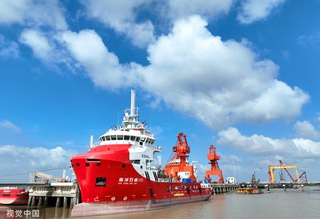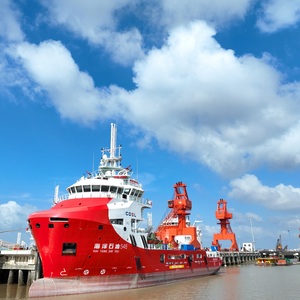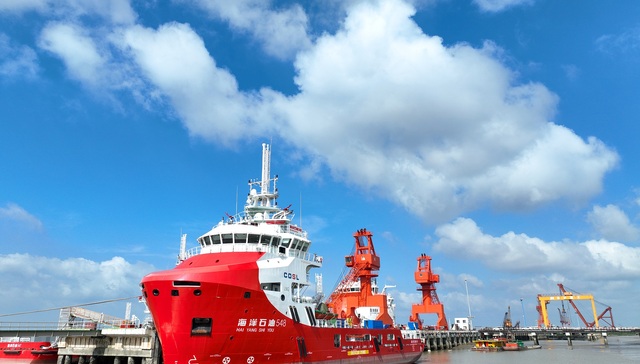By XU Ning
The liquified natural gas (LNG) market has gone wild since the Russian-Ukraine war broke out. So has the market for shipping it around. Even at record high rates, there are not nearly enough ships to go around. Wall Street Journal reported in August that no LNG carriers were available in the Atlantic basin for the next two months, citing a shipbroker. But the unprecedented situation may present new opportunities for shipbuilders in Asia.
Countries in Europe are scrambling to secure natural gas supplies for the winter as Russia cut off flow in Nord Stream 1. Germany has leased five floating LNG terminals since May, two to be put to use this year. In August, The UK received liquefied natural gas shipments from Australia and Oman. Before that, it received almost nothing from these two countries due to long distances and high costs.
The US has been Europe’s main supplier. The world’s top natural gas producer exported 57 billion cubic meters in the first half of the year, 70 percent of which were Europe bound. (Europe has been seeking to buy more LNG from Qatar, although the country has to fill the orders of its Asian buyers first.) The flurry of shipping in the Atlantic basin has exacerbated the carrier shortage and pushed up LNG freight rates everywhere.
Shipping rates have doubled since last year to over US0,000 per day and are expected to rise even further this winter, according to pricing agency Spark Commodities.

Demand for LNG carriers was rising even before the Russia-Ukraine war. Natural gas is considered a transition fuel to renewable energies, and in the absence of pipelines, can only be transported in a low-temperature liquified form by the sea. Orders for LNG carriers reached a record high of 86 in 2021. Another 111 orders were placed in the first eight months of this year.
Almost all the world's LNG carriers are built in South Korea, China and Japan, although Japan hasn’t delivered since 2019. China and South Korea have been in a tug of war to dominate the world’s overall shipbuilding market – China regained its No 1 position last year as a result of surging container ship orders – but South Korea is better with more technologically advanced ships. It started developing LNG carriers in the 1990s and currently takes about 90 percent of the market.
Most of China’s ships are for bulk commodities such as iron ore and crude oil. The country has been trying to catch up on LNG carriers since the early 2000s, with the first carrier delivered in 2008, by Hudong-Zhonghua. It remained the only builder of LNG carriers in China until this year.
In March, Jiangnan Shipyard was commissioned to build two carriers for UAE’s Abu Dhabi National Oil Company. The next month, Dalian Shipbuilding Industry Company landed a deal to build four carriers for Qatar Energy. All three are subsidiaries of China State Shipbuilding Company.
By July, China had received 32 orders this year, the most since 2008, but still far behind South Korea’s 77, split among three companies, Korea Shipbuilding & Offshore Engineering (33), Samsung Heavy Industries (24) and Daewoo Shipbuilding & Marine Engineering (20).
China is on par with South Korea in terms of technology, efficiency and delivery time, said CAO Bo, a researcher at China Association of The National Shipbuilding Industry, but is unable to take many orders due to capacity constraints. This will be alleviated as Jiangnan Shipyard and Dalian Shipbuilding Industry Company go into operation.
“But it will still take some time to get the capacity up. Shipyards don’t make just one kind of ship. How much capacity is given to LNG carriers depends on the overall production plan,” Cao said.
The three South Korean shipbuilders are also operating at full capacity with orders stretching to 2025. They are also grappling with labor shortages and continuing losses.
By some estimates, the world will need over 500 new LNG carriers by 2030 to meet its swelling demand for natural gas. Qatar alone plans to increase its natural gas production by 64 percent from the 2019 level by 2027 and has been on a shopping spree for carriers. With a price tag of US$240 million per boat, the market will easily surpass US$100 billion.
More Chinese players may enter the game. Yangzijiang Shipbuilding, China’s largest non-state shipbuilder, signed with French naval engineering company Gaztransport & Technigaz this month to license a key LNG technology. This will enable Yangzijiang to develop its own carriers soon. Reportedly it has been in talks with Denmark's Celsius for an order of 10 to 12 carriers.
Additionally, Greek shipowner Dynagas is in the process of booking with Dalian Shipbuilding Industry Co. Hudong Zhonghua also expects orders from Qatar in Q4.





